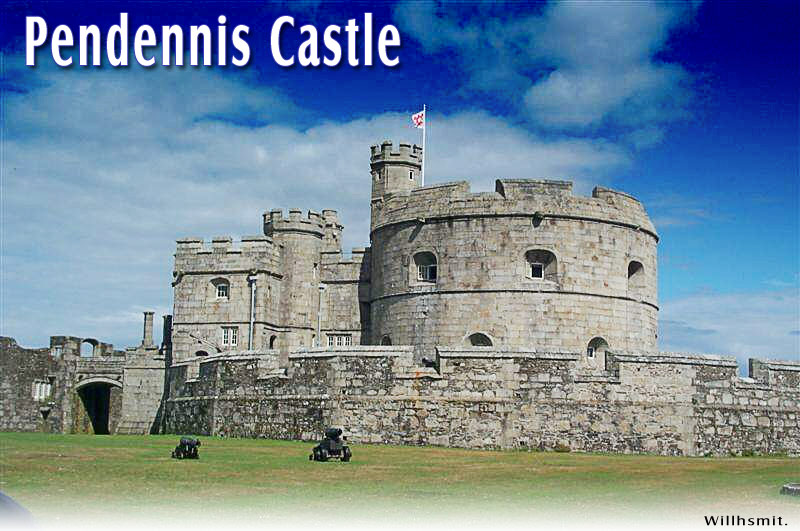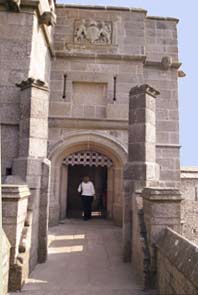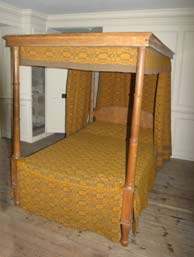

 Pendennis
Castle
Pendennis
Castle
Falmouth, Cornwall TR11 4LP
Tel. 01326 316594
Fax. 01326 319911
Map Ref: SW 827315
50.14722°N 5.04777°W
Location: Pendennis headland, half mile from Falmouth town centre. 'Land Train' Service from town (summer). Castle signposted from the town.
How
to get there: Road: On Pendennis Head 1m SE of
Falmouth.
Train: stops at Falmouth Docks.

 Pendennis
Castle has defended the anchorage of the Carrick Roads for over 450
years. Today you re-visit the castle's history from Tudor times to the
re-fortification in both world wars. Along with a museum and discovery
centre are displays of coastal defence armament and access to the former
secret installations.
Pendennis
Castle has defended the anchorage of the Carrick Roads for over 450
years. Today you re-visit the castle's history from Tudor times to the
re-fortification in both world wars. Along with a museum and discovery
centre are displays of coastal defence armament and access to the former
secret installations.
In the late 1530's Henry VIII was under threat of war from France and Spain because he had divorced his Catholic wife, Catherine of Aragon. As a consequence, Henry set about the fortification of the whole of England's south coast.
Between the years 1540 and 1545, the River Fal, had two forts constructed to guard its wide entrance - St Mawes on the east bank and Pendennis on the west. St Mawes had a great deal of effort put into its construction, with quality stone and decorative carvings. Pendennis, on the other hand, was a simple round tower and gate enclosed by a lower curtain wall.
During the reign of Elizabeth I, an extra wall was constructed - encircling the structure, and bastions were built at Pendennis. In the year 1595, the Spanish attacked Mounts Bay - Newlyn and Penzance.
The garrisons at Pendennis and St Mawes, were hurriedly reinforced and improved in preparation for the coming Spanish Invasion. However the Spanish invasion never came and the only attacks on the castles were from the English during the Civil War.
 The
historic siege of Pendennis Castle began in 1646 when parliamentary forces
attacked the fortress from both land and sea. They quickly cut the castle's
lines of communication and supplies with trenches and gun positions, running
from Gyllyngvase on the west across to the area that currently is occupied
by the docks.
The
historic siege of Pendennis Castle began in 1646 when parliamentary forces
attacked the fortress from both land and sea. They quickly cut the castle's
lines of communication and supplies with trenches and gun positions, running
from Gyllyngvase on the west across to the area that currently is occupied
by the docks.
Cromwell's Roundheads set up headquarters in Falmouth at Arwenack House, the burnt out home to the Killigrew family. The Garrison at Pendennis under the command of the 80 year old Sir John Arundel and assisted by Sir Henry Killigrew ( Member of Parliament), held out for six months, being reduced to eating horse and dog meat before their final surrender to the Parliamentarian force. Pendennis had been the penultimate stronghold - after Raglan Castle -in the country to hold out for the King, after earlier giving sanctuary to Queen Henrietta Maria, and the Prince of Wales (Charles II), before their escape to France.
The location of the castle high on the hill overlooking the surrounding area and town gave the defenders a great advantage, enabling them to hold out for so long against the Parliamentarian force. St Mawes, on the opposite bank was in a weaker position strategically - built half way up the hill, purely as as a seaward deterrent, the castle had no defence from a land based attack. The governor at St Mawes immediately surrendered to the Parliamentarian forces. Both forts were part of Britain's coastal defence system during both World Wars.
The castle has a Discovery Centre, which allows visitors to explore the fascinating history of the castle, complete with interactive displays and activities, including an exhibit on Tudor battles. There are many medieval re-enactments staged at Pendennis. A Land Train' runs from Falmouth to the castle car park during the summer months.
Properties near Pendennis Castle

Bed & Breakfast
With stunning sea views over Falmouth Bay and situated opposite Gyllyngvase Beach this charming Bed and breakfast has bar and sun terrace.Car Park on site |
|

Self Catering
Two delightful self-catering holiday cottages, each sleeping 4/5. Situated in the perfect location for exploring Cornwalls countryside, gardens, coasts, sailing waters and cycle trails. Beautiful rural setting on a Cornish working farm. Large enclosed garden, private parking |
|

Self Catering
Trewince, a family run business for over 30 years and with a personal touch is an oasis of beauty and calm within its acres of park and woodland. Near to the villages of Portscatho, Gerrans and St Mawes. Close to tranquil beaches, secluded coves and beautiful countryside with spectacular views where you really can get away from the stresses of every day life. |
|

Self Catering Static Caravan + Self Catering + Holiday Park
Seaview Holiday Park is a family run site with outstanding sea views and countryside views, near to Kennack Sands beach. An ideal location where a warm welcome and relaxing holiday awaits you.in our Holiday Chalets and Holiday Caravans - with the opportunity to buy your own holiday home in Cornwall |
|

Bed & Breakfast
Old Temperance House, in St Keverne Square, is a lovingly renovated, Period Village House. For B & B, we have 4 En Suite Bedrooms (weekly rates available), plus a pretty Self Catering Cottage sleeping 3. |
|

Self Catering
Luxurious waterside apartment. Superb position overlooking the harbour, ideal for town and beaches. Sailing facilities nearby. Sleeps 2. Furnished to a high standard. Private parking with two adjacent car parking spaces available in a gated garage |
|

Self Catering
Holidays Cottages on the cornish Coast - enjoy a break in a stunning Cornish coastal location - explore the beautiful beaches and coves of the Cornish Coast |
|

Self catering
Helston, on the Lizard Peninsula, is ideally located for exploring South West Cornwall. A delightfully restored stone building that is secluded and cosy in its countryside setting -located at the end of a country lane, the views over Tregonning Hill are lovely and the entire property is secluded and peaceful. Sleeps 2 people ( Pets: one dog by arrangement) |
|

Self Catering
Falmouth Holiday Homes offer a wide range of luxury self catering retreats, ranging from modern apartments right on the Pier, pretty seaside cottages and loftstyle apartments right up to sprawling mansions with swimming pools and direct beach access. We welcome dogs in many properties, provide all linen and towels and supply highchairs and travel cots. |
|

Self catering
Detached 2 bedroom Holiday Home in the thriving village of St Keverne - a period property with wood burning stove and central heating. 1 Double and 1 single bedrooms. Appointed to a high standard the cottage is as private as you want, but Kevin and Claire - the owners are close by for any help you may need. There is a BBQ in the courtyard. |
|

Self catering
Coastal Holiday Cottages in Cornwall - Simply Sea Views has a range of holiday cottages From cosy fishermens cottages overlooking bustling harbours to contemporary retreats set over golden Cornish beaches. Holiday cottages sleeping 4, 5, 6 and 10 people |
|

Self Catering Static Caravan Holiday Park Glamping Camping + Touring
Camping and Touring Parks nestled in the Cornish countryside, offering home from home comforts and accessible facilities, generous pitches, impressive site shops and warm welcomes. |
|

Self Catering Glamping B&B Camping Holiday Cottages caravana
Flushing Holiday Cottages offer a choice of self catering cottages in the pretty village of Flushing. Our character cottages are carefully chosen to ensure your accommodation is of the highest standard, all houses have WiFi, well equipped kitchens, comfortable beds and most have wood-burners. The village has a choice of pubs, a shop and a fabulous seafood restaurant and is extremely dog-friendly. |
|
 |
|
Promoting
your business on Cornwall Online |
|
Cornwall
Online is a trading name of ITS WEB DESIGN - COL DIRECT
Cornwall Online Website by ITS WEB DESIGN - COL DIRECT. Tel 01579 557343 Please ensure that you confirm all details with the Advertiser before Booking We recommend that you take out Holiday Insurance on ALL Bookings |